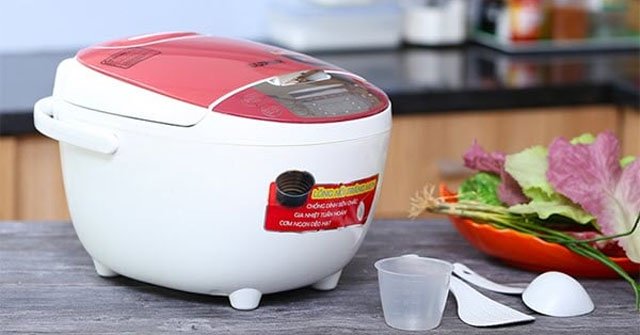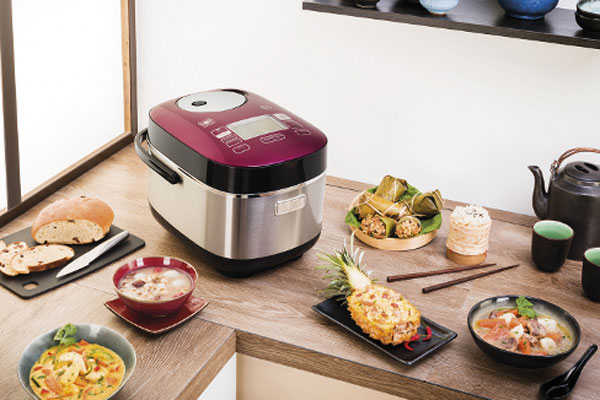Structure and working principle of electric rice cooker
Electric cooker is an extremely familiar and close to each of us. However, when asked about the structure and operation principles of electric rice cookers, not everyone knows. Below, TipsMake.com will help you answer this issue.

Structure of electric rice cooker
Before going into understanding the structure of electric rice cooker, let's take a look at some of the most popular and popular rice cookers today.
Common types of rice cookers include:
- Covered rice cooker: This type of rice is also known as an instant rice cooker. Their main function is simply to cook and reheat rice.
- Removable rice cooker: This pot has a design, simpler model than a rice cooker with a lid. However, they are cheaper.
- High-frequency rice cooker: This type of pot is integrated with many automatic functions, they are equipped with copper wires that emit a magnetic field, acting directly on the heart of the pot to cook food.
- Electronic rice cooker: is a modern type of cooker, equipped with led screens, installed automatic cooking modes and electronic circuits.
Below we will go into the general structure of electric rice cookers.
A rice cooker is usually composed of 6 main parts:
Pot shells
The cooker cover is like a outer shell of the rice cooker, usually made of plastic or stainless steel. Pot shells work:
- Keeping the temperature constant during the rice cooker is active, they also help to keep the kettle better.
- Help protect parts inside the rice cooker and keep users safe.
- In addition, thanks to this shell, the rice cooker becomes more beautiful, more aesthetic.
Lid
There are 2 types of pot lid:
- Type of lid (also known as instant cover): When using the rice cooker, you will have a little difficulty in cleaning, but they are safer. Currently, some manufacturers have designed additional types of lids but still removable inside, making it more convenient for cleaning.
- Removable cap type: This cover helps you to clean and clean easily. However, during cooking, the removable lid will drain a lot of steam, which can be dangerous for users, especially for families with the elderly and young children.
Pot body
This is a very important part, they work to protect the pot, prevent the pot from bumps, and this is also the main heat retention unit.
Today, with more modern technology, the body is usually designed with 3 layers:
- The innermost layer has an exothermic effect, making the pot evenly warm.
- The next layer is the porcelain insulating layer, which is responsible for keeping the whole rice cooker heat.
- In addition to the crust, this layer is often decorated with textures to increase the aesthetics of the rice cooker.
Hot plate
This is the main heating element for the pot, helping the rice to be cooked. A rice cooker with a standard thermostat requires heat transfer channels, which helps to spread the heat evenly on the bottom of the saucepan so that the rice is cooked evenly.
Pot core
The core of the current pot is usually lighter, has better heat resistance and is usually covered with non-stick coating to prevent the rice from sticking, while helping the cleaning process be the most convenient.
Control unit
This unit is attached to the rice cooker, they use relays, which switch from cooking mode to keep warm mode.
Particularly with electronic rice cooker, this control unit has more complex features:
- Controlled by electronic circuits.
- LCD information is displayed on the screen.
- Adjust by button, not by lever like rice cooker.
- Installed many cooking modes.
Besides the 6 main parts mentioned above, the rice cooker is also equipped with a number of accompanying accessories such as steaming pots, measuring cups, rice spoons .

Learn how the rice cooker works
When we give the rice cooker a power source, and at the same time we turn on the cooking mode, the lever will transmit the motion as the switch pushes up and is attracted by the magnet, the lever remains in place, even if We let go.
The controller supplies heat to the thermostat, which then converts the energy into heat.
When there is heat, the pot is heated to make the rice and water inside boil and form rice.
During the cooking process, the rice cooker cover will have a role to keep the temperature stable. When the rice reaches a certain level, the controller will automatically switch to keep warm mode (Warm mode).
Steam relief valves also take part in the cooking process, helping to adjust the water level and pressure level in the rice cooker.
In general, all types of rice cookers will have the same principle of operation as a little different in the operation of the controller.
Above, we have helped you understand the structure and operation of the rice cooker. Hopefully, our sharing will help you better understand the rice cooker so that we can use them more effectively.
You should read it
- Electric rice cooker and electric rice cooker: which type to buy?
- Cause and remedy error of rice cooker jumping soon
- Which diamond rice cooker is the best?
- Tell you how to cook delicious rice with a rice cooker
- Which sample of Sharp industrial electric rice cooker is the best?
- Top 3 electric rice cookers for the best diabetics
- Is Nagakawa sugar rice cooker good? Should I buy it?
- Rice separator for sugar - Smart solution for diabetics & dieters
May be interested
- 5 Model of cheap mini rice cooker for students and few people
 the smallest rice cooker with a capacity of 0.5 1 liter, 1 liter price is less than 1.5 million vnd for students and families 1-3 people, cook rice quickly, evenly, save electricity.
the smallest rice cooker with a capacity of 0.5 1 liter, 1 liter price is less than 1.5 million vnd for students and families 1-3 people, cook rice quickly, evenly, save electricity. - How to use electric pressure cooker to ensure safety for the family
 how to use electric pressure cookers safely and effectively is not well known. the following article will tell you how to use electric pressure cooker properly. stay tuned!
how to use electric pressure cookers safely and effectively is not well known. the following article will tell you how to use electric pressure cooker properly. stay tuned! - Is Nagakawa sugar rice cooker good? Should I buy it?
 let tipsmake.com learn about the quality and price of nakawa sugar rice cooker - one of the products that are receiving the most attention today!
let tipsmake.com learn about the quality and price of nakawa sugar rice cooker - one of the products that are receiving the most attention today! - Where to buy genuine Cuckoo electric rice cooker?
 if you are looking for an address to buy a cheap cuckoo rice cooker, don't miss the article below. quantum will help you find a reputable address.
if you are looking for an address to buy a cheap cuckoo rice cooker, don't miss the article below. quantum will help you find a reputable address. - Rice separator for sugar - Smart solution for diabetics & dieters
 split sugar rice cookers are considered the perfect solution for diabetic patients, overweight and obese people and those on diets.
split sugar rice cookers are considered the perfect solution for diabetic patients, overweight and obese people and those on diets. - 5 reasons to convince you to use high-frequency rice cooker
 for these 5 reasons, every family should equip themselves with at least one high-frequency rice cooker in the kitchen.
for these 5 reasons, every family should equip themselves with at least one high-frequency rice cooker in the kitchen. - How to make yogurt with electric cooker
 with the simple way of making yogurt by electric rice cooker, you can easily do it at home to have delicious and nutritious yogurt jars.
with the simple way of making yogurt by electric rice cooker, you can easily do it at home to have delicious and nutritious yogurt jars. - How to make baked moon cakes simply by electric rice cooker
 you want to make moon cakes for your family to enjoy but you don't have all the tools and oven, take advantage of the rice cooker and try the following simple baking method, you will have the cake grilled mid-autumn festival, very delicious and equally beautiful.
you want to make moon cakes for your family to enjoy but you don't have all the tools and oven, take advantage of the rice cooker and try the following simple baking method, you will have the cake grilled mid-autumn festival, very delicious and equally beautiful. - Which electric pressure cooker should buy the best today?
 electric pressure cooker is a household dish that many women look to buy when the weather is winter. so which electric pressure cooker is the best today? let's find out.
electric pressure cooker is a household dish that many women look to buy when the weather is winter. so which electric pressure cooker is the best today? let's find out. - Which type of pressure cooker, electronic pressure cooker should be purchased?
 if you are wondering if you should buy a pressure cooker or electric pressure cooker, see the article below to facilitate the cooking process.
if you are wondering if you should buy a pressure cooker or electric pressure cooker, see the article below to facilitate the cooking process.










 The cause of cars burning and timely handling
The cause of cars burning and timely handling self-maintenance steps, generator maintenance
self-maintenance steps, generator maintenance Learn the structure, installation and use of air conditioners
Learn the structure, installation and use of air conditioners Google Home: You won't regret changing these 5 settings
Google Home: You won't regret changing these 5 settings How to proof and bake bread in an Instant Pot
How to proof and bake bread in an Instant Pot How to clean window blinds fast without creating nasty slime or dust clouds
How to clean window blinds fast without creating nasty slime or dust clouds